Jason Schneider
the Camera Collector
The Voigtlander Vitessa: Most elegant rangefinder folder 35 of all time
The “Mercedes 300SL” of cameras it was doomed by its brilliant design!
By Jason Schneider
The Voigtlander Vitessa was introduced in 1950 in a bid to challenge the wildly popular German-made Kodak Retinas, specifically the Retina II (type 014) of 1949-1950, the first folding Retina with a combined range/viewfinder. But Voigtlander was determined to come up with something special to knock the Retina off its exalted perch, and they sure did. The Vitessa replaced the conventional single-side-hinged folding bed with a pair of “barn doors,” hinged on both sides, that fold very flat when closed, and snap open to support the extended lens board on 4 robust spring-loaded struts on the corners when you press the shutter release. At the same time, a left-handed “combi-plunger” pops up from left of center in the camera top, extending 1-3/8-inches above the top of the camera. To advance the film and fire the shutter, you alternately press the shutter release and the plunger, which (with practice) gives a maximum manual firing rate of about 2.5 frames per sec, or marginally faster than a conventional top-mounted wind lever or bottom-mounted trigger. Not surprisingly, the Vitessa derived its catchy model name from the Anglo/French word “vitesse,” which means “rapidity, the act or quality of acting or moving fast” and it delivers on its promise when dexterously operated.
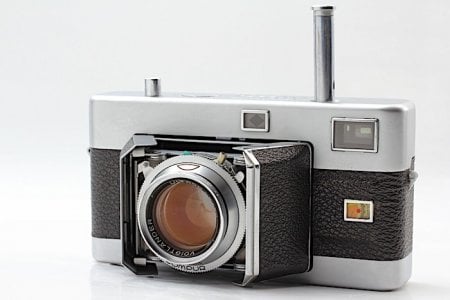
Voigtlander Vitessa A3 c 1952. Note 50mm f/2 Ultron lens in Synchro-Compur shutter, diamond shaped pattern in rangefinder window
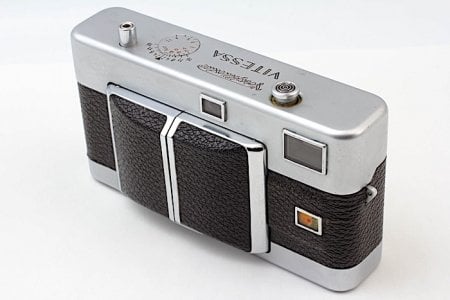
Exquisite minimalist slimline form factor of closed Vitessa is unique among folding rangefinder 35s and one of its most appealing features.
Another reason the folding Vitessa is a great action camera is that it facilitates viewing and focusing while shooting rapidly. Just keep your eye at the eyepiece while viewing and you can easily maintain focus with the thumbwheel on the back of the camera. The combined range/viewfinder is small by current standards, but it’s reasonably bright and the rangefinder patch is well defined, nicely separated, and easy to focus. My old (c.1952) Vitessa (model A3) has a diamond shaped rangefinder patch (later ones are conventionally square), tiny neck strap lugs (they’re absent on the earliest models), and a separate slide-on accessory shoe (later models have built-in cold shoes). To close the camera, press in on two little “lunette” logos above and below the lens surround, ease the doors fully shut, and press down on the “combi-plunger” until it’s secured in the retracted position. Note: If the plunger won’t stay in when you retract it, this can be an expensive repair, so check it before you buy.
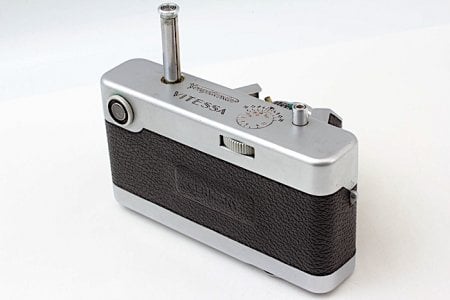
Voigtlander Vitessa A3 back showing thumbwheel for focusing, extended combo-plunger for film advance, well placed shutter release. It's fast!
For a second-tier camera (the interchangeable lens Voigtlander Prominent was the company’s top tier pro model) priced at about $160 brand new, the Vitessa is exquisitely made and gorgeously finished—almost equal to a Leica M3. And in its closed position, it’s exquisitely slim and has an elegant form factor measuring 5.5 x 3.0 x 1.8 inches (with slight differences depending on model). However, due to its complex mechanism and heavy metal construction it weighs between 660g and 700g (about 1.5 pounds), which is a bit too heavy for comfortably toting in a trousers pocket. Fortunately, Voigtlander offered a selection of nicely crafted brown leather “flat form” ever-ready cases. Unfortunately, their leather carrying straps are permanently affixed to the sides of the case and can’t be replaced when worn without the services of a cobbler (not easy to find these days), and to make matters worse, the bottom part of the case covers the neck strap lugs, making it challenging to attach a generic substitute.
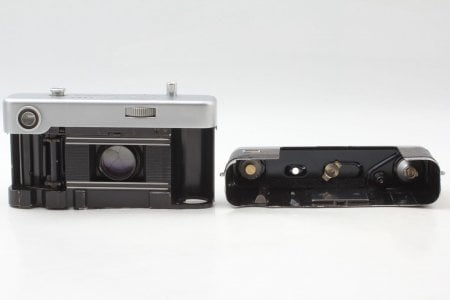
Voigtlander Vitessa A3 with back removed shows exquisite fit and finish of interior components. Camera is surprisingly robust and durable.
A Vitessa Taxonomy: An overview of the different models
There are four principal variants of the classic Voigtlander Vitessa, the type A, type N, type L, and type T. Only the latter two were officially labeled as such by the factory—the A and N are informal designations used by collectors and historians. Voigtlander also used the Vitessa name on a variety of other cameras of completely different design such as the Vitessa 500L, 500 SE, 1000 SR, the Vitessa D 105 AF point & shoot, and the Vitessa 126 CS that took 126 Instamatic cartridges! These are obviously beyond the scope of this article.
Vitessa A (1950-1954). The very first Vitessa has a non-removable back and a pressure plate connected to the body, a removable accessory shoe, and no neck strap lugs. The second version has a removable slide-off back which includes the pressure plate, a lens threaded for screw-in filters, and a Compur-Rapid MX shutter. Models A1 and A2 have manual parallax compensation, the A3 and all later models have automatic parallax compensation, and the A4 and all subsequent models feature a fixed cold shoe on top, and a flash sync terminal on the barn door.
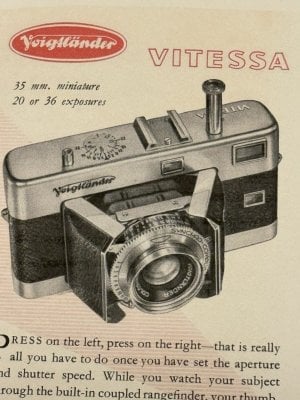
Excerpt of ad for Voigtlander N with Synchro-Compur geometric speed shutter, 50mm f/3.5 Color-Skopar lens, highlighting fast firing prowess.
Vitessa N (1954). All models have bayonet filter mounts on the lens, Synchro-Compur LVS shutters with self-timer and EV values 3 to 18, a fixed accessory shoe on top, PC flash terminal on the barn door, automatic parallax compensation, and a permanently mounted accessory shoe on top. Lenses are the 50mm f/2 Ultron or the 50mm f/3.5 Color-Skopar.
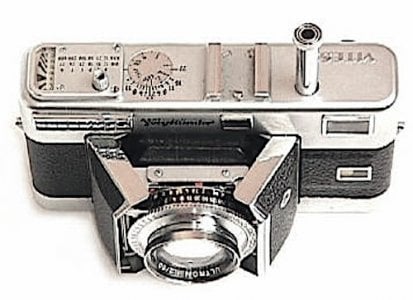
Vitessa L, top view, showing meter index, selenium meter cell with "bubble" cover. Meter needle reads out in EV numbers.
Vitessa L (1954). The principal defining feature of this series is the built-in selenium meter—early Vitessa L’s have a flat pattern selenium cell cover with ABCDEF meter table and ASA settings 6 to 200; later modes have the conventional plastic “beaded pattern” meter cover, a BCDEFG meter table, and ASA settings 12 to 400. Other features are the same as the N models above, except that EV values now extend from 2 to 18.
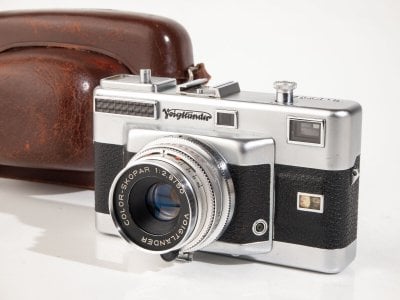
Voigtlander Vitessa T with 50mm f/2.8 Color-Skopar, leather case. More versatile but less esthetically appealing, T models were so-so sellers.
Vitessa T (1957). Available in 3 versions, the Vitessa T’s mark a new phase, the transformation of the elegant folding Vitessa with non-interchangeable lenses into a chunky solid-bodied interchangeable lens camera with a DKL mount. A matching series of 4 DKL bayonet Voigtlander lenses, ranging from 35mm to 135mm, mount directly in front of the Synchro-Compur LVS shutter in a manner akin to that used in the top-of-the-line Voigtlander Prominent. The Vitessa’s signature combi-plunger film advance parallax-compensating range/viewfinder and other basic features have been retained, and like the L series all T-series models have built-in uncoupled selenium meters with a needle ans scale calibrated in EV numbers.
Detailed breakdown of Vitessa sub-types
Vitessa A1: Original model without removable back, but pressure plate connected to body (as in the Rollei 35). Compur-Rapid 1-1/500 sec shutter with old type sync on lens, no neck strap lugs or accessory shoe, diamond shaped rangefinder patch, coated 50mm f/2 Ultron lens.
Vitessa A2: All features same as Vitessa A1 above except that the back, now with integral pressure plate, is removable.
Vitessa A3: All features same as Vitessa A2 above, except Synchro-Compur MX 1-1/500 sec shutter, neck strap lugs on camera, auto parallax compensation by masking system, no fixed accessory shoe.
Vitessa A4: All features same as Vitessa A3 above except PC flash terminal on left-hand barn door.
Vitessa A5: Flash terminal on barn door, ring for neck strap on body, 50mm f/2 Ultron lens, sub-variants with different logos and typefaces.
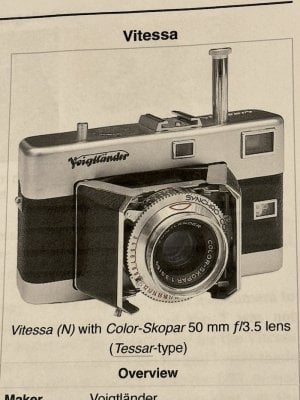
Front view of Vitessa N with Synchro-Compur shutter, coupled LVS settings, and 50mm f/3.5 Colo-Skopar lens.
Vitessa N1: Synchro-Compur MX 1-1/500 sec shutter, shutter speed and aperture rings not coupled, square rangefinder patch, rings for neck strap on body, 50mm f/3.5 Skopar lens.
Vitessa N2: Same as Vitessa N1 above, except for coupled shutter speed and aperture rings, 50mm f/2 Ultron lens.
Vitessa L1: Features parallel those of Vitessa N2, but with the addition of a built-in uncoupled selenium meter with square pattern meter grid, sensitivity settings ASA 6 to 200, 50mm f/2 Ultron lens.
Vitessa L2: Same as Vitessa L1 above except for bubble pattern plastic cover for selenium meter.
Vitessa L3: Same as Vitessa L2 above except meter sensitivity settings range from ASA 12 to 400, Weston film speeds eliminated.
Vitessa L4: Same as Vitessa L3 above, but meter sensitivity settings range from ASA 6 to 200, 50mm f/2.8 Color-Skopar lens.
Vitessa L5: Same as Vitessa L4 above, except for 50mm f/3.5 Color-Skopar lens.
Vitessa T1, T2, and T3: All T-series models feature solid (non-folding) bodies with integral DKL bayonet mount that accept 4 interchangeable Voigtlander bayonet mount lenses ranging from 35mm to 135mm (see text for details), 50mm f/2.8 Color-Skopar standard lens. Vitessa T1 has square pattern window on built-in uncoupled selenium meter cell, sensitivity settings from ASA 6 to 200 ; Vitessa T2 has same features as T1 except for plastic bubble cover for selenium meter cell; Vitessa T3 has the same features as Vitessa T2 except meter sensitivity settings range from ASA 12 to 400. A dummy (attrappe) non-functioning version made for display purposes has a metal cylinder in place of the lens.
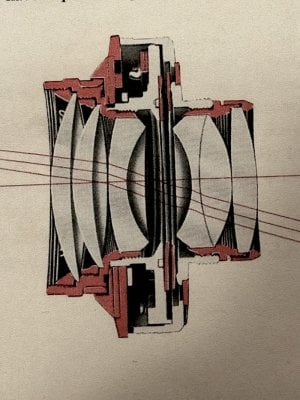
Cross section of 50mm f/2 Ultron lens showing its unique 6-element, 5-group design. It's an outstanding performer with vintage rendition.
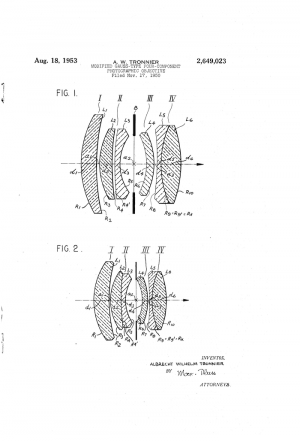
US Patent for 50mm f/2 Ultron lens issued to Albrecht Tronnier in 1953. Note application was filed in 1950 when lens appeared on Vitessa A1.
Folding Vitessas were available with a choice of 3 lenses. All models offered the 50mm f/2 Ultron, plus the 50mm f/3.5 Color-Skopar and/or the 50mm f/2.8 Color-Skopar. All these high-performance Voigtlander lenses were designed by Albrecht Tronnier, the renowned German lens designer who worked for Schneider Kreuznach before WWII and signed on as Voigtlander’s top optical designer in 1944. His most famous design was the 7-element, 5-group 50mm f/1.5 Nokton for the Voigtlander Prominent of 1950, but in that same year he also came up with the innovative 6-element, 5-group 50mm f/2 Ultron that was the most common lens fitted to folding Vitessas and was also available in Voigtlander Prominent mount. According to a 1952 article published in the venerable British magazine Amateur Photographer the 50mm f/2 Ultron edged out the 50mm f/2 Leitz Summitar and even the first version of the legendary 50mm f/2 Summicron in terms of overall image quality! I can personally attest that it’s an outstanding lens that captures spectacularly sharp, contrasty images at moderate apertures (f/4 to f/11), tends to flare dramatically when shooting into bright light sources, and has some barrel distortion that can be noticeable when shooting rectilinear subjects at close distances. Wide open at f/2 it captures detailed but “dreamy” images with attractive bokeh and a definite “vintage look.” If you want a little more sharpness and a little less “dreaminess,” stop its 10-bladed diaphragm down to f/2.8. In short, it’s a delightful lens. Incidentally, the 50mm f/3.5 and f/2.8 Color-Skopar are tweaked 4-element, 3-group Tessars that deliver impressive on-film performance. Note: Later folding Vitessas have 5-bladed lens diaphragms but brighter viewfinders—you win some, you lose some-
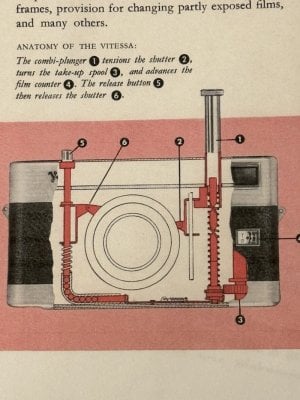
Functional diagram of the Vitessa showing interaction of the combi-plunger and shutter release mechanisms for rapid firing.
When you turn the thumbwheel to focus the Vitessa, the lens moves in and out on a robust, elaborately geared precision focusing mechanism and employs a very high-quality leather bellows that’s more supple and durable than those fitted to most other folding cameras. It’s also secured by a gasketing material made of a fine rope, which is far superior to the foam material used in many other folders. As a result, the bellows in Vitessas are very durable and seldom require repair or replacement. However, the minimum focusing distance is 1 meter (the closest distance listed the footage scales of export models is 3.5 feet, but it will focus to under 3 feet). Two Proximeters, consisting of close-up lenses paired with optical range/viewfinder adapters were available for shooting close-ups, and you can still find them on the used market at about $50 to $75 a pop.
With its compact dimensions and combi-plunger film advance mast (which earned it the nickname “lighthouse” in German), the Vitessa requires a distinctive 2-handed grip to hold the camera steady while keeping the fingers of your left hand from obscuring the front viewfinder window. I grasp the right-hand end of the camera with my right hand, holding my right thumb over the milled focusing wheel, and my right forefinger perched over the shutter release. I form my left hand into a “C” shape with my left thumb held firmly against the bottom back edge of the camera, my extended middle finger perched over the combi-plunger, and the remaining 3 fingers of my left hand curled downward out of the way and pressing against the front of the camera for added support. I’m sure there are other grips that are equally effective, but once you find the one that works best for you, practice, and stick with it until it becomes second nature.
Great features of the folding Vitessa
1. All but the earliest models have a cool “slotted screw top with a red line” inset into the folding bottom-mounted rewind crank. When film is loaded, it turns to confirm that the film has been correctly loaded and is advancing properly.
2. When the rewind crank handle is lifted out if its storage slot and moved to the side without lifting it upward into rewinding position, it can be used as a built-in “mini stand” to stabilize the camera when it’s placed on a flat surface such as a tabletop.
3. Knurled surfaces on the shutter-seed setting ring and on the bottom of the aperture ring facilitate setting the exposure.
4. With the back removed you can not only set the (manually zeroed) frame counter, but also the adjacent film type reminder, both of which are visible on the front of the closed camera or through a port in the case. Very clever, but sadly most of the film speed and film type settings are obsolete so you must assign new meanings if you want to use them as a reminder.
5. The Vitessa’s lift-and-twist bottom lock is simple, effective, and secure. Opening the camera reveals a beautifully finished interior with right-to-left film advance, and a thin, gorgeously machined back section that slides onto the main body with uncommon precision. Best way to load the Vitessa is to insert the film leader into the thin, slotted take-up spool in the left, wind it on with the combi-plunger and pull the film cartridge to the right, insert it in the film chamber, set the frame counter and close the camera. Like everything else about the camera, if you do it the Vitessa way you’ll be just fine.
6. As previously mentioned, the Vitessa was the first folding rangefinder 35 to provide automatic parallax compensation over its entire focusing range, starting with the model A3 of 1952. This feature never appeared on any Retina, even the posh Retina IIIC, which had a high magnification range/viewfinder with multiple projected viewfinder frame lines. All Vitessas with this feature moved the opaque outer borders of the frame to achieve parallax compensation and it’s hard to notice—unless you hold your eye up to the finder and turn the focusing wheel back and forth over its entire range.
7. The folding Vitessa is unconventional and can be challenging for newcomers unaccustomed to its idiosyncrasies, but it’s an exquisitely made machine oozing with vintage character and capable of commendably high imaging performance even by current standards. While no longer the astounding bargain it was a decade or more ago, it’s still a great choice for vintage user- collectors. And I ought to know cuz I are one-
8. The Vitessa case is extremely high quality, like all Voigtlander leather works of the period. All are arguably more beautiful and better crafted than Leica leather works of the same era.
9. If the Vitessa had a Leitz engraving and were placed side by side with a Leica M3, it would indeed appear to be a Leica product; such is its precision, fit, and flawless satin chrome finish.
Vitessas and their discontents
1. A smallish range/viewfinder. The Vitessa’s rangefinder has a base length 39mm and its magnification is about 0.6x, giving an effective base length (EBL) of 23.4mm, so accurately focusing the 50mm f/2 Ultron lens over its full range is well within its capabilities (Note: in the absence of official specs these figures are based on measuring and examining my own camera). The Vitessa also has a relatively small eyepiece and the overall image in early examples (such as my treasured 1952 model A3) has a greenish tint to make the orangey rangefinder patch stand out. This lowers the brightness somewhat, so the viewing image is not too bright by modern standards. Soooo, despite having an excellent rangefinder with a crisply defined rangefinder patch and good separation between the primary and secondary (moving) images, I’d rate the early Vitessa’s range/viewfinder a solid “meh.” meaning it’s eminently useable but not great. Later models appear to have noticeably brighter range/viewfinders which would up their rating to “OK” or “pretty good.”
2. Repairs on Vitessas (all types) are hard to find and likely to be expensive. Of course, the same can be said for most vintage cameras, and Vitessas are generally reliable despite their mechanical complexity. According to ace camera repairman Bill Moretz of Charlottesville, VA fixing a Vitessa is typically a little more labor intensive than fixing the average camera, but it’s not a bear, like fettling a bull’s-eye Contarex or a Contax I, to cite two infamous examples.
3. New parts for Vitessas are long gone, so cannibalization of broken or incomplete Vitessas is often the only solution when existing parts cannot be made to work on an otherwise functional camera. Serious Vitessa collectors often acquire “parts cameras” at lower cost for this purpose or to upgrade models that have cosmetic imperfections.
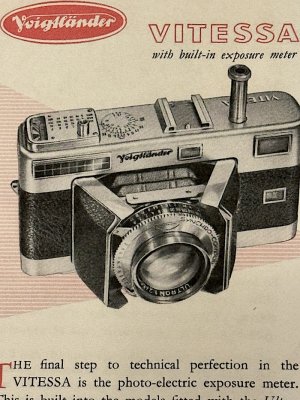
Excerpt of ad for early Vitessa L with square patter meter grid, 50mm f/2 Ultron lens highlights its built-in meter and "technical perfection."
In 1954, Voigtlander introduced the Vitessa L, the last of the non-interchangeable-lensed Vitessas, with a built-in uncoupled selenium cell meter. The meter was made by Bertram, the famous German maker of high-quality exposure meters and it employed a very high-grade selenium cell that’s relatively unaffected by continuous exposure to light and was suspended in a spring-loaded “cradle” to minimize damage due to vibration. As a result, a surprisingly high percentage of these 70+ year old meters still work! The meter needle in a scale adjacent to the shutter release reads out in EV (aka LVS) numbers, corresponding to the EV scale with coupled aperture and shutter speed settings on the camera, and the camera’s Synchro-Compur MXV 1/1/500 sec plus B leaf shutter has modern geometric shutter speeds (1/30, 1/60 sec, etc.) and provides MX flash sync plus a mechanical self-timer setting. On early Vitessa L models with a flat selenium grid, the meter had sensitivity settings of ABCDEF or ASA 6-200; on later models with a conventional “bubble type” selenium grid the film speed settings were BCDEFG or ASA 12 to 400. In all other respects these cameras closely parallel the non-metered folding Vitessas.
Regrettably, despite its many thoughtful features, and impressive field performance, the folding Vitessa was a grand and glorious technological dead end. There was simply no way to upgrade it with modern features such as projected parallax compensating viewfinder frame lines or interchangeable lenses without compromising its unique character and abandoning its stunning slimline form. Voigtlander tried its best, but the result was merely a decent interchangeable lens version that failed to spark the public imagination or sell in sufficient numbers.
In 1957, in response to Kodak bringing forth the “c” and “C” series Retinas with a range of interchangeable lens components from wide angle to telephoto, Voigtlander decided to go them one better and bring forth the rigid (non-folding) Vitessa T with a DKL bayonet mount developed jointly with Deckel, the Munich-based makers of the Compur shutter. This allowed the use of fully interchangeable lenses mounted directly in front of a Synchro-Compur leaf shutter, a system they had pioneered on the Voigtlander Prominent of 1950. There were 3 versions of the Vitessa T and four lenses were available, the 6-element 5-group 35mm f/3.4 Skoparet (a retrofocus design) a 50mm f/2.8 Color-Skopar (a 4-element, 3-group Tessar type), a 100mm f/4.8 Dynaret (a 6-element, 4-group Sonnar design), and a 135mm f/4 Super-Dynaret of unknown construction. In all other respects the features of the Voigtlander T models closely paralleled those of the folding models in the A, N, and L series, but they required separate viewfinders, never offered the 50mm f/2 Ultron lens as an alternative, and were boxy, chunky, and the very antithesis if the elegantly slim, graceful form factor of the folding Vitessas. According to one creditable source, a total 42,123 Vitessa Ts were made (including non-functional dummy models for store display) so it was neither an abject failure nor a roaring success. You can currently buy a clean working Voigtlander Vitessa T with 50mm f/2.8 Color-Skopar lens for only $50 to $100, a far lower price than a folding Vitessa in the model A-,N-, or L-series, which generally go for $150 to $350 depending on specific model, condition, and of course the seller.
The folding Voigtlander Vitessa rangefinder 35s of 1950 to 1960 are charmingly idiosyncratic, and for many, an acquired taste but they’re also timeless classics, exquisite mechanical creations, and superb analog picture takers. They are a testament to what was possible at the height of the of the great optical-mechanical era that peaked in the ‘50s and ‘60s. You may rest assured, we shall not see their like again.
.
The “Mercedes 300SL” of cameras it was doomed by its brilliant design!
By Jason Schneider
The Voigtlander Vitessa was introduced in 1950 in a bid to challenge the wildly popular German-made Kodak Retinas, specifically the Retina II (type 014) of 1949-1950, the first folding Retina with a combined range/viewfinder. But Voigtlander was determined to come up with something special to knock the Retina off its exalted perch, and they sure did. The Vitessa replaced the conventional single-side-hinged folding bed with a pair of “barn doors,” hinged on both sides, that fold very flat when closed, and snap open to support the extended lens board on 4 robust spring-loaded struts on the corners when you press the shutter release. At the same time, a left-handed “combi-plunger” pops up from left of center in the camera top, extending 1-3/8-inches above the top of the camera. To advance the film and fire the shutter, you alternately press the shutter release and the plunger, which (with practice) gives a maximum manual firing rate of about 2.5 frames per sec, or marginally faster than a conventional top-mounted wind lever or bottom-mounted trigger. Not surprisingly, the Vitessa derived its catchy model name from the Anglo/French word “vitesse,” which means “rapidity, the act or quality of acting or moving fast” and it delivers on its promise when dexterously operated.

Voigtlander Vitessa A3 c 1952. Note 50mm f/2 Ultron lens in Synchro-Compur shutter, diamond shaped pattern in rangefinder window

Exquisite minimalist slimline form factor of closed Vitessa is unique among folding rangefinder 35s and one of its most appealing features.
Another reason the folding Vitessa is a great action camera is that it facilitates viewing and focusing while shooting rapidly. Just keep your eye at the eyepiece while viewing and you can easily maintain focus with the thumbwheel on the back of the camera. The combined range/viewfinder is small by current standards, but it’s reasonably bright and the rangefinder patch is well defined, nicely separated, and easy to focus. My old (c.1952) Vitessa (model A3) has a diamond shaped rangefinder patch (later ones are conventionally square), tiny neck strap lugs (they’re absent on the earliest models), and a separate slide-on accessory shoe (later models have built-in cold shoes). To close the camera, press in on two little “lunette” logos above and below the lens surround, ease the doors fully shut, and press down on the “combi-plunger” until it’s secured in the retracted position. Note: If the plunger won’t stay in when you retract it, this can be an expensive repair, so check it before you buy.

Voigtlander Vitessa A3 back showing thumbwheel for focusing, extended combo-plunger for film advance, well placed shutter release. It's fast!
For a second-tier camera (the interchangeable lens Voigtlander Prominent was the company’s top tier pro model) priced at about $160 brand new, the Vitessa is exquisitely made and gorgeously finished—almost equal to a Leica M3. And in its closed position, it’s exquisitely slim and has an elegant form factor measuring 5.5 x 3.0 x 1.8 inches (with slight differences depending on model). However, due to its complex mechanism and heavy metal construction it weighs between 660g and 700g (about 1.5 pounds), which is a bit too heavy for comfortably toting in a trousers pocket. Fortunately, Voigtlander offered a selection of nicely crafted brown leather “flat form” ever-ready cases. Unfortunately, their leather carrying straps are permanently affixed to the sides of the case and can’t be replaced when worn without the services of a cobbler (not easy to find these days), and to make matters worse, the bottom part of the case covers the neck strap lugs, making it challenging to attach a generic substitute.

Voigtlander Vitessa A3 with back removed shows exquisite fit and finish of interior components. Camera is surprisingly robust and durable.
A Vitessa Taxonomy: An overview of the different models
There are four principal variants of the classic Voigtlander Vitessa, the type A, type N, type L, and type T. Only the latter two were officially labeled as such by the factory—the A and N are informal designations used by collectors and historians. Voigtlander also used the Vitessa name on a variety of other cameras of completely different design such as the Vitessa 500L, 500 SE, 1000 SR, the Vitessa D 105 AF point & shoot, and the Vitessa 126 CS that took 126 Instamatic cartridges! These are obviously beyond the scope of this article.
Vitessa A (1950-1954). The very first Vitessa has a non-removable back and a pressure plate connected to the body, a removable accessory shoe, and no neck strap lugs. The second version has a removable slide-off back which includes the pressure plate, a lens threaded for screw-in filters, and a Compur-Rapid MX shutter. Models A1 and A2 have manual parallax compensation, the A3 and all later models have automatic parallax compensation, and the A4 and all subsequent models feature a fixed cold shoe on top, and a flash sync terminal on the barn door.

Excerpt of ad for Voigtlander N with Synchro-Compur geometric speed shutter, 50mm f/3.5 Color-Skopar lens, highlighting fast firing prowess.
Vitessa N (1954). All models have bayonet filter mounts on the lens, Synchro-Compur LVS shutters with self-timer and EV values 3 to 18, a fixed accessory shoe on top, PC flash terminal on the barn door, automatic parallax compensation, and a permanently mounted accessory shoe on top. Lenses are the 50mm f/2 Ultron or the 50mm f/3.5 Color-Skopar.

Vitessa L, top view, showing meter index, selenium meter cell with "bubble" cover. Meter needle reads out in EV numbers.
Vitessa L (1954). The principal defining feature of this series is the built-in selenium meter—early Vitessa L’s have a flat pattern selenium cell cover with ABCDEF meter table and ASA settings 6 to 200; later modes have the conventional plastic “beaded pattern” meter cover, a BCDEFG meter table, and ASA settings 12 to 400. Other features are the same as the N models above, except that EV values now extend from 2 to 18.

Voigtlander Vitessa T with 50mm f/2.8 Color-Skopar, leather case. More versatile but less esthetically appealing, T models were so-so sellers.
Vitessa T (1957). Available in 3 versions, the Vitessa T’s mark a new phase, the transformation of the elegant folding Vitessa with non-interchangeable lenses into a chunky solid-bodied interchangeable lens camera with a DKL mount. A matching series of 4 DKL bayonet Voigtlander lenses, ranging from 35mm to 135mm, mount directly in front of the Synchro-Compur LVS shutter in a manner akin to that used in the top-of-the-line Voigtlander Prominent. The Vitessa’s signature combi-plunger film advance parallax-compensating range/viewfinder and other basic features have been retained, and like the L series all T-series models have built-in uncoupled selenium meters with a needle ans scale calibrated in EV numbers.
Detailed breakdown of Vitessa sub-types
Vitessa A1: Original model without removable back, but pressure plate connected to body (as in the Rollei 35). Compur-Rapid 1-1/500 sec shutter with old type sync on lens, no neck strap lugs or accessory shoe, diamond shaped rangefinder patch, coated 50mm f/2 Ultron lens.
Vitessa A2: All features same as Vitessa A1 above except that the back, now with integral pressure plate, is removable.
Vitessa A3: All features same as Vitessa A2 above, except Synchro-Compur MX 1-1/500 sec shutter, neck strap lugs on camera, auto parallax compensation by masking system, no fixed accessory shoe.
Vitessa A4: All features same as Vitessa A3 above except PC flash terminal on left-hand barn door.
Vitessa A5: Flash terminal on barn door, ring for neck strap on body, 50mm f/2 Ultron lens, sub-variants with different logos and typefaces.

Front view of Vitessa N with Synchro-Compur shutter, coupled LVS settings, and 50mm f/3.5 Colo-Skopar lens.
Vitessa N1: Synchro-Compur MX 1-1/500 sec shutter, shutter speed and aperture rings not coupled, square rangefinder patch, rings for neck strap on body, 50mm f/3.5 Skopar lens.
Vitessa N2: Same as Vitessa N1 above, except for coupled shutter speed and aperture rings, 50mm f/2 Ultron lens.
Vitessa L1: Features parallel those of Vitessa N2, but with the addition of a built-in uncoupled selenium meter with square pattern meter grid, sensitivity settings ASA 6 to 200, 50mm f/2 Ultron lens.
Vitessa L2: Same as Vitessa L1 above except for bubble pattern plastic cover for selenium meter.
Vitessa L3: Same as Vitessa L2 above except meter sensitivity settings range from ASA 12 to 400, Weston film speeds eliminated.
Vitessa L4: Same as Vitessa L3 above, but meter sensitivity settings range from ASA 6 to 200, 50mm f/2.8 Color-Skopar lens.
Vitessa L5: Same as Vitessa L4 above, except for 50mm f/3.5 Color-Skopar lens.
Vitessa T1, T2, and T3: All T-series models feature solid (non-folding) bodies with integral DKL bayonet mount that accept 4 interchangeable Voigtlander bayonet mount lenses ranging from 35mm to 135mm (see text for details), 50mm f/2.8 Color-Skopar standard lens. Vitessa T1 has square pattern window on built-in uncoupled selenium meter cell, sensitivity settings from ASA 6 to 200 ; Vitessa T2 has same features as T1 except for plastic bubble cover for selenium meter cell; Vitessa T3 has the same features as Vitessa T2 except meter sensitivity settings range from ASA 12 to 400. A dummy (attrappe) non-functioning version made for display purposes has a metal cylinder in place of the lens.

Cross section of 50mm f/2 Ultron lens showing its unique 6-element, 5-group design. It's an outstanding performer with vintage rendition.

US Patent for 50mm f/2 Ultron lens issued to Albrecht Tronnier in 1953. Note application was filed in 1950 when lens appeared on Vitessa A1.
Folding Vitessas were available with a choice of 3 lenses. All models offered the 50mm f/2 Ultron, plus the 50mm f/3.5 Color-Skopar and/or the 50mm f/2.8 Color-Skopar. All these high-performance Voigtlander lenses were designed by Albrecht Tronnier, the renowned German lens designer who worked for Schneider Kreuznach before WWII and signed on as Voigtlander’s top optical designer in 1944. His most famous design was the 7-element, 5-group 50mm f/1.5 Nokton for the Voigtlander Prominent of 1950, but in that same year he also came up with the innovative 6-element, 5-group 50mm f/2 Ultron that was the most common lens fitted to folding Vitessas and was also available in Voigtlander Prominent mount. According to a 1952 article published in the venerable British magazine Amateur Photographer the 50mm f/2 Ultron edged out the 50mm f/2 Leitz Summitar and even the first version of the legendary 50mm f/2 Summicron in terms of overall image quality! I can personally attest that it’s an outstanding lens that captures spectacularly sharp, contrasty images at moderate apertures (f/4 to f/11), tends to flare dramatically when shooting into bright light sources, and has some barrel distortion that can be noticeable when shooting rectilinear subjects at close distances. Wide open at f/2 it captures detailed but “dreamy” images with attractive bokeh and a definite “vintage look.” If you want a little more sharpness and a little less “dreaminess,” stop its 10-bladed diaphragm down to f/2.8. In short, it’s a delightful lens. Incidentally, the 50mm f/3.5 and f/2.8 Color-Skopar are tweaked 4-element, 3-group Tessars that deliver impressive on-film performance. Note: Later folding Vitessas have 5-bladed lens diaphragms but brighter viewfinders—you win some, you lose some-

Functional diagram of the Vitessa showing interaction of the combi-plunger and shutter release mechanisms for rapid firing.
When you turn the thumbwheel to focus the Vitessa, the lens moves in and out on a robust, elaborately geared precision focusing mechanism and employs a very high-quality leather bellows that’s more supple and durable than those fitted to most other folding cameras. It’s also secured by a gasketing material made of a fine rope, which is far superior to the foam material used in many other folders. As a result, the bellows in Vitessas are very durable and seldom require repair or replacement. However, the minimum focusing distance is 1 meter (the closest distance listed the footage scales of export models is 3.5 feet, but it will focus to under 3 feet). Two Proximeters, consisting of close-up lenses paired with optical range/viewfinder adapters were available for shooting close-ups, and you can still find them on the used market at about $50 to $75 a pop.
With its compact dimensions and combi-plunger film advance mast (which earned it the nickname “lighthouse” in German), the Vitessa requires a distinctive 2-handed grip to hold the camera steady while keeping the fingers of your left hand from obscuring the front viewfinder window. I grasp the right-hand end of the camera with my right hand, holding my right thumb over the milled focusing wheel, and my right forefinger perched over the shutter release. I form my left hand into a “C” shape with my left thumb held firmly against the bottom back edge of the camera, my extended middle finger perched over the combi-plunger, and the remaining 3 fingers of my left hand curled downward out of the way and pressing against the front of the camera for added support. I’m sure there are other grips that are equally effective, but once you find the one that works best for you, practice, and stick with it until it becomes second nature.
Great features of the folding Vitessa
1. All but the earliest models have a cool “slotted screw top with a red line” inset into the folding bottom-mounted rewind crank. When film is loaded, it turns to confirm that the film has been correctly loaded and is advancing properly.
2. When the rewind crank handle is lifted out if its storage slot and moved to the side without lifting it upward into rewinding position, it can be used as a built-in “mini stand” to stabilize the camera when it’s placed on a flat surface such as a tabletop.
3. Knurled surfaces on the shutter-seed setting ring and on the bottom of the aperture ring facilitate setting the exposure.
4. With the back removed you can not only set the (manually zeroed) frame counter, but also the adjacent film type reminder, both of which are visible on the front of the closed camera or through a port in the case. Very clever, but sadly most of the film speed and film type settings are obsolete so you must assign new meanings if you want to use them as a reminder.
5. The Vitessa’s lift-and-twist bottom lock is simple, effective, and secure. Opening the camera reveals a beautifully finished interior with right-to-left film advance, and a thin, gorgeously machined back section that slides onto the main body with uncommon precision. Best way to load the Vitessa is to insert the film leader into the thin, slotted take-up spool in the left, wind it on with the combi-plunger and pull the film cartridge to the right, insert it in the film chamber, set the frame counter and close the camera. Like everything else about the camera, if you do it the Vitessa way you’ll be just fine.
6. As previously mentioned, the Vitessa was the first folding rangefinder 35 to provide automatic parallax compensation over its entire focusing range, starting with the model A3 of 1952. This feature never appeared on any Retina, even the posh Retina IIIC, which had a high magnification range/viewfinder with multiple projected viewfinder frame lines. All Vitessas with this feature moved the opaque outer borders of the frame to achieve parallax compensation and it’s hard to notice—unless you hold your eye up to the finder and turn the focusing wheel back and forth over its entire range.
7. The folding Vitessa is unconventional and can be challenging for newcomers unaccustomed to its idiosyncrasies, but it’s an exquisitely made machine oozing with vintage character and capable of commendably high imaging performance even by current standards. While no longer the astounding bargain it was a decade or more ago, it’s still a great choice for vintage user- collectors. And I ought to know cuz I are one-
8. The Vitessa case is extremely high quality, like all Voigtlander leather works of the period. All are arguably more beautiful and better crafted than Leica leather works of the same era.
9. If the Vitessa had a Leitz engraving and were placed side by side with a Leica M3, it would indeed appear to be a Leica product; such is its precision, fit, and flawless satin chrome finish.
Vitessas and their discontents
1. A smallish range/viewfinder. The Vitessa’s rangefinder has a base length 39mm and its magnification is about 0.6x, giving an effective base length (EBL) of 23.4mm, so accurately focusing the 50mm f/2 Ultron lens over its full range is well within its capabilities (Note: in the absence of official specs these figures are based on measuring and examining my own camera). The Vitessa also has a relatively small eyepiece and the overall image in early examples (such as my treasured 1952 model A3) has a greenish tint to make the orangey rangefinder patch stand out. This lowers the brightness somewhat, so the viewing image is not too bright by modern standards. Soooo, despite having an excellent rangefinder with a crisply defined rangefinder patch and good separation between the primary and secondary (moving) images, I’d rate the early Vitessa’s range/viewfinder a solid “meh.” meaning it’s eminently useable but not great. Later models appear to have noticeably brighter range/viewfinders which would up their rating to “OK” or “pretty good.”
2. Repairs on Vitessas (all types) are hard to find and likely to be expensive. Of course, the same can be said for most vintage cameras, and Vitessas are generally reliable despite their mechanical complexity. According to ace camera repairman Bill Moretz of Charlottesville, VA fixing a Vitessa is typically a little more labor intensive than fixing the average camera, but it’s not a bear, like fettling a bull’s-eye Contarex or a Contax I, to cite two infamous examples.
3. New parts for Vitessas are long gone, so cannibalization of broken or incomplete Vitessas is often the only solution when existing parts cannot be made to work on an otherwise functional camera. Serious Vitessa collectors often acquire “parts cameras” at lower cost for this purpose or to upgrade models that have cosmetic imperfections.

Excerpt of ad for early Vitessa L with square patter meter grid, 50mm f/2 Ultron lens highlights its built-in meter and "technical perfection."
In 1954, Voigtlander introduced the Vitessa L, the last of the non-interchangeable-lensed Vitessas, with a built-in uncoupled selenium cell meter. The meter was made by Bertram, the famous German maker of high-quality exposure meters and it employed a very high-grade selenium cell that’s relatively unaffected by continuous exposure to light and was suspended in a spring-loaded “cradle” to minimize damage due to vibration. As a result, a surprisingly high percentage of these 70+ year old meters still work! The meter needle in a scale adjacent to the shutter release reads out in EV (aka LVS) numbers, corresponding to the EV scale with coupled aperture and shutter speed settings on the camera, and the camera’s Synchro-Compur MXV 1/1/500 sec plus B leaf shutter has modern geometric shutter speeds (1/30, 1/60 sec, etc.) and provides MX flash sync plus a mechanical self-timer setting. On early Vitessa L models with a flat selenium grid, the meter had sensitivity settings of ABCDEF or ASA 6-200; on later models with a conventional “bubble type” selenium grid the film speed settings were BCDEFG or ASA 12 to 400. In all other respects these cameras closely parallel the non-metered folding Vitessas.
Regrettably, despite its many thoughtful features, and impressive field performance, the folding Vitessa was a grand and glorious technological dead end. There was simply no way to upgrade it with modern features such as projected parallax compensating viewfinder frame lines or interchangeable lenses without compromising its unique character and abandoning its stunning slimline form. Voigtlander tried its best, but the result was merely a decent interchangeable lens version that failed to spark the public imagination or sell in sufficient numbers.
In 1957, in response to Kodak bringing forth the “c” and “C” series Retinas with a range of interchangeable lens components from wide angle to telephoto, Voigtlander decided to go them one better and bring forth the rigid (non-folding) Vitessa T with a DKL bayonet mount developed jointly with Deckel, the Munich-based makers of the Compur shutter. This allowed the use of fully interchangeable lenses mounted directly in front of a Synchro-Compur leaf shutter, a system they had pioneered on the Voigtlander Prominent of 1950. There were 3 versions of the Vitessa T and four lenses were available, the 6-element 5-group 35mm f/3.4 Skoparet (a retrofocus design) a 50mm f/2.8 Color-Skopar (a 4-element, 3-group Tessar type), a 100mm f/4.8 Dynaret (a 6-element, 4-group Sonnar design), and a 135mm f/4 Super-Dynaret of unknown construction. In all other respects the features of the Voigtlander T models closely paralleled those of the folding models in the A, N, and L series, but they required separate viewfinders, never offered the 50mm f/2 Ultron lens as an alternative, and were boxy, chunky, and the very antithesis if the elegantly slim, graceful form factor of the folding Vitessas. According to one creditable source, a total 42,123 Vitessa Ts were made (including non-functional dummy models for store display) so it was neither an abject failure nor a roaring success. You can currently buy a clean working Voigtlander Vitessa T with 50mm f/2.8 Color-Skopar lens for only $50 to $100, a far lower price than a folding Vitessa in the model A-,N-, or L-series, which generally go for $150 to $350 depending on specific model, condition, and of course the seller.
The folding Voigtlander Vitessa rangefinder 35s of 1950 to 1960 are charmingly idiosyncratic, and for many, an acquired taste but they’re also timeless classics, exquisite mechanical creations, and superb analog picture takers. They are a testament to what was possible at the height of the of the great optical-mechanical era that peaked in the ‘50s and ‘60s. You may rest assured, we shall not see their like again.
.
Last edited:
KoNickon
Nick Merritt
Wonderful writeup! I don't think I've ever seen such a detailed overview. Beautifully conceived cameras and quite unlike anything else. They and the Prominent demonstrate Voigtlander's quality and originality. I have a couple of the folding L versions but I'd have to look closely to figure out which models. One has the Ultron (but a persistent light leak unfortunately) and the other is a very smooth example with the 2.8 Color-Skopar. I have two of the Ts, one of which sadly is hors de combat because the fork tines in the film cartridge chamber will bend -- weird.
The Turnit finder for the T is a brilliant design, and fully usable for the fixed lens models too. Also, though I've never seen one in real life, there was a really clever everready case that when opened up revealed a flash bulb socket and reflector. More originality!
In use the Vitessas are certainly fast handling, though it takes a little practice to pop the barn doors open (and fold them again) and retract that plunger and get it to stay put. I can't see these being anybody's everyday camera, but they sure are marvels.
The Turnit finder for the T is a brilliant design, and fully usable for the fixed lens models too. Also, though I've never seen one in real life, there was a really clever everready case that when opened up revealed a flash bulb socket and reflector. More originality!
In use the Vitessas are certainly fast handling, though it takes a little practice to pop the barn doors open (and fold them again) and retract that plunger and get it to stay put. I can't see these being anybody's everyday camera, but they sure are marvels.
Jason Schneider
the Camera Collector
Hi, Thanks for your kind words. I agree the Turnit finder is a gem, and also that few would consider the Vitessa an "everyday camera" these days, although I do run about one 36-exposure roll per month through my Vitessa A3 and L1 with great satisfaction. As for opening the barn doors, some open fully when you press the shutter release and others require some light finger assistance to click into shooting position--no big deal. I strongly recommend you keep a finger over the combi-plunger when opening the camera to help dampen its upward thrust, which can be quite forceful. Happy shooting with yours.Wonderful writeup! I don't think I've ever seen such a detailed overview. Beautifully conceived cameras and quite unlike anything else. They and the Prominent demonstrate Voigtlander's quality and originality. I have a couple of the folding L versions but I'd have to look closely to figure out which models. One has the Ultron (but a persistent light leak unfortunately) and the other is a very smooth example with the 2.8 Color-Skopar. I have two of the Ts, one of which sadly is hors de combat because the fork tines in the film cartridge chamber will bend -- weird.
The Turnit finder for the T is a brilliant design, and fully usable for the fixed lens models too. Also, though I've never seen one in real life, there was a really clever everready case that when opened up revealed a flash bulb socket and reflector. More originality!
In use the Vitessas are certainly fast handling, though it takes a little practice to pop the barn doors open (and fold them again) and retract that plunger and get it to stay put. I can't see these being anybody's everyday camera, but they sure are marvels.
Hcompton79
Established
The Retina IIa does have automatic parallax compensation, it moves the whole finder image through a shifting lens element in the viewfinder, though I believe it only achieves horizontal parallax compensation. This was dropped on the C folders. Though the IIIS has a wonderful finder with automatic switchable automatic parallax compensating framelines in both the vertical and horizontal dimensions, something I don't think the Vitessa T had something comparable to.
Does the Vitessas viewfinder do both horizontal and vertical parallax compensation or just one of the two?
Does the Vitessas viewfinder do both horizontal and vertical parallax compensation or just one of the two?
Thank you again for a great write-up on an uncommon camera: not as many made, and unique features not common on other cameras.
I adjusted the Rangefinder of my Vitessa N several years ago, which requires taking the top off to adjust, and putting it back on to see if it is correct. Several iterations as the mechanism is "uncommon", I remember three set screws that must be adjusted to set horizontal and vertical. I've read that Voigtlander made a special "tool" for repair services to do this, basically the eyepiece that fit onto the camera, leaving the mechanism exposed. I bought a second top from KEH used for a few $ back then, swore I'd cut it up if I needed to do this adjustment again. I also have the Vitessa T, with the 50/2.8 Skopar. Great lens.
I adjusted the Rangefinder of my Vitessa N several years ago, which requires taking the top off to adjust, and putting it back on to see if it is correct. Several iterations as the mechanism is "uncommon", I remember three set screws that must be adjusted to set horizontal and vertical. I've read that Voigtlander made a special "tool" for repair services to do this, basically the eyepiece that fit onto the camera, leaving the mechanism exposed. I bought a second top from KEH used for a few $ back then, swore I'd cut it up if I needed to do this adjustment again. I also have the Vitessa T, with the 50/2.8 Skopar. Great lens.
KoNickon
Nick Merritt
I should add that Stephen Gandy's article on the Vitessa at his website is what introduced me to these cameras in the first place. I commend that article to all.
wlewisiii
Just another hotel clerk
skopar steve
Well-known
Very nice article Jason. I bought a Vitessa T from a junk store on a whim. I was without a rangefinder at the time, so I took a chance for $90.
It was a bit awkward to use at first, however the images it produced were excellent. Have not used it for many years but your wonderful article is inspiring me to take it out for a spin.
Vitessa T color skopar 50mm 2.8 Kodak Ektar 100

It was a bit awkward to use at first, however the images it produced were excellent. Have not used it for many years but your wonderful article is inspiring me to take it out for a spin.
Vitessa T color skopar 50mm 2.8 Kodak Ektar 100

The key word is elegant. Zeiss had a tendency to produce not so beautiful cameras. The Zeiss Contessa 35 continued that tradition.Sorry, but having used both, I'll vote for the Zeiss Contessa 35 as a far more elegant folding 35mm camera. Much more reliable and a finer lens as well.
View attachment 4838569
KoNickon
Nick Merritt
Very nice article Jason. I bought a Vitessa T from a junk store on a whim. I was without a rangefinder at the time, so I took a chance for $90.
It was a bit awkward to use at first, however the images it produced were excellent. Have not used it for many years but your wonderful article is inspiring me to take it out for a spin.
Vitessa T color skopar 50mm 2.8 Kodak Ektar 100
View attachment 4838570
KoNickon
Nick Merritt
That's a great picture.Very nice article Jason. I bought a Vitessa T from a junk store on a whim. I was without a rangefinder at the time, so I took a chance for $90.
It was a bit awkward to use at first, however the images it produced were excellent. Have not used it for many years but your wonderful article is inspiring me to take it out for a spin.
Vitessa T color skopar 50mm 2.8 Kodak Ektar 100
View attachment 4838570
This is the most detailed info on the Vitessa available on the net. Just like that! Thanks @Jason Schneider !
I have an Ultron model, no accy shoe. The most elegant looking model IMHO is no meter and no shoe.
However it needs work as film transport gets bogged. I adjusted focus and RF which wasn’t difficult.
I have an Ultron model, no accy shoe. The most elegant looking model IMHO is no meter and no shoe.
However it needs work as film transport gets bogged. I adjusted focus and RF which wasn’t difficult.
wlewisiii
Just another hotel clerk
I maintain that it is elegant but I will accept that others don't agree. Personally I consider it far better looking than the Vitessa with it's phallic film transport.The key word is elegant. Zeiss had a tendency to produce not so beautiful cameras. The Zeiss Contessa 35 continued that tradition.
Godfrey
somewhat colored
Excellent article, thank you!
I used to see these cameras in the camera and tourist shop windows all over Manhattan and The Bronx when I was in high school in the late 1960s/early 1970s. I knew nothing about them but they were always interesting to my eye: a fascinating design with its double doors and smoothly finished body. It's great to know more about them now.
I'm tempted to find one, just to enjoy an occasional shooting session, etc. But my favorite RF camera of that period (barring the Leica M) is the Kodak Retina IIc, and I already have several restored and ready to shoot examples of them ... and not enough time to use them all!
"Most elegant rangefinder folder of all time..."? I don't know about that, . But the Vitesse is certainly one of the most interesting in terms of the mechanical design and lovely styling. The Retina IIc is no slouch on being elegant either. Eh? A matter of personal preference, I guess.
G
I used to see these cameras in the camera and tourist shop windows all over Manhattan and The Bronx when I was in high school in the late 1960s/early 1970s. I knew nothing about them but they were always interesting to my eye: a fascinating design with its double doors and smoothly finished body. It's great to know more about them now.
I'm tempted to find one, just to enjoy an occasional shooting session, etc. But my favorite RF camera of that period (barring the Leica M) is the Kodak Retina IIc, and I already have several restored and ready to shoot examples of them ... and not enough time to use them all!
"Most elegant rangefinder folder of all time..."? I don't know about that, . But the Vitesse is certainly one of the most interesting in terms of the mechanical design and lovely styling. The Retina IIc is no slouch on being elegant either. Eh? A matter of personal preference, I guess.
G
skopar steve
Well-known
Thank you KoNickon.
skopar steve
Well-known
I wish there were a way to mount my Vitessa T 50mm 2.8 color skopar to Leica M mount or LTM to use on my other rangefinders. Any ideas?
titrisol
Bottom Feeder
skopar steve
Well-known
Jason Schneider
the Camera Collector
The Kodak Retina IIa of 1951 to 1954 is a great camera and my favorite folding Retina, but it does not provide automatic parallax compensation. The Retina IIIS of 1958 to 1961 has multiple auto-indexing, parallax compensating frame lines, but it is a later, more technologically advanced camera introduced when the Vitessas were winding down. The folding Vitessas I covered use the opaque outer borders of the frame, which move diagonally to provide both horizontal and vertical parallax compensation, but due to size limitations they chose not to integrate frame lines into the Vitessa's range/viewinder. Too bad.The Retina IIa does have automatic parallax compensation, it moves the whole finder image through a shifting lens element in the viewfinder, though I believe it only achieves horizontal parallax compensation. This was dropped on the C folders. Though the IIIS has a wonderful finder with automatic switchable automatic parallax compensating framelines in both the vertical and horizontal dimensions, something I don't think the Vitessa T had something comparable to.
Does the Vitessas viewfinder do both horizontal and vertical parallax compensation or just one of the two?
titrisol
Bottom Feeder
I don't know if this would help?I wish there were a way to mount my Vitessa T 50mm 2.8 color skopar to Leica M mount or LTM to use on my other rangefinders. Any ideas?
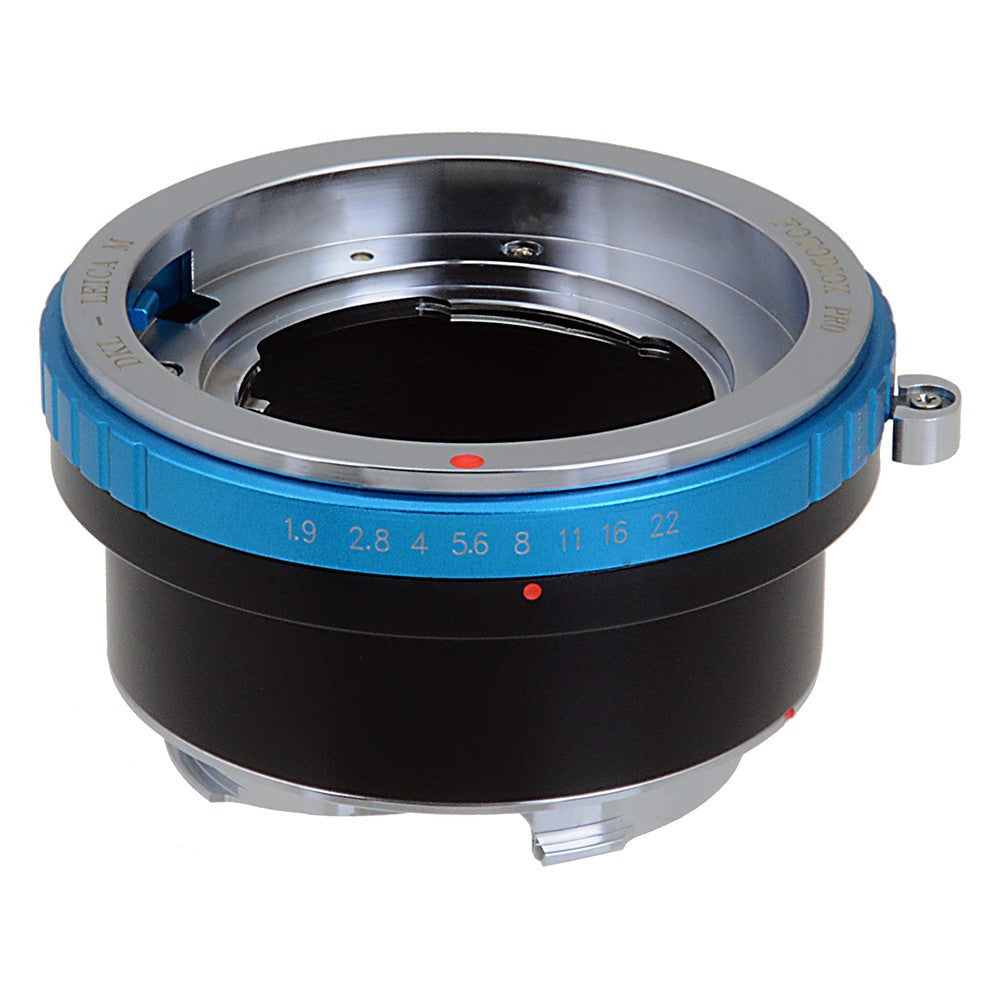
Pro Adapter - Deckel-Bayonett Lens to Leica M RF Camera w/ Leica 6-Bit
Fotodiox Pro adapters feature all-metal, no plastic construction to create a secure connection between your glass and camera that will not degrade over time, keeping the lens-camera connection secure with every use. We use chrome plated brass mounts for enhanced durability and reliability. All...
Share:
-
This site uses cookies to help personalise content, tailor your experience and to keep you logged in if you register.
By continuing to use this site, you are consenting to our use of cookies.




